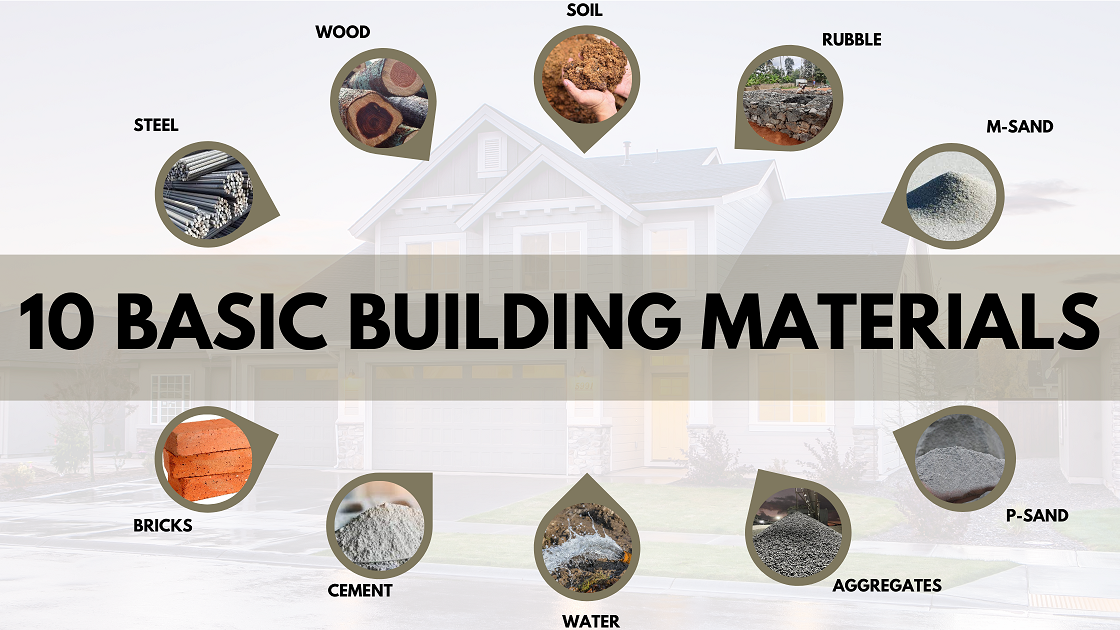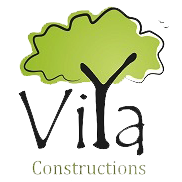If you were asked to name the 10 basic materials that went into the making of your home, will you be able to do it? Well, this post is just that, to help you identify and understand the 10 basic civil construction materials that makes your shelter rock solid.

SOIL
Though soil is not a building material per se, it plays a very important role in construction. Before you start the construction, it is imperative that you test the quality of the soil in the plot. The soil test results will help you make key choices like the type of foundation to be used, the depth of the foundation, the type of cement used for construction etc.
The most important soil characteristics that affect the foundation are the water content, presence of vegetation or remains of cut trees, land filling and proximity to mining areas. Soil testing should be done in detail and by a qualified agent before the start of construction.
Read up more about soil testing here.
RUBBLE STONES
Rubble is used for foundation when the underlying soil condition is strong. The purpose of the rubble foundation is to transfer the load of the building to the underlying soil. For this purpose, a trench is made, and rubbles are arranged in it throughout the house. By this process, the weight of the building is transferred uniformly to the ground.
While doing rubble foundation, it is important to use stones that are similar in shape. Wedge shaped stones are inserted using hammers in between the stones to fill the gaps. Cement is not used in this stage. This is called Dry Rubble (DR) and it rests under the soil.
In the next stage, the rubbles are packed together just as in Dry Rubble. But the only difference is that the stones are held together with mortar. This is called Random Rubble (RR) and this layer rests above the soil. A layer of mortar separates the Dry Rubble and Random Rubble.
Watch how Rubble Trench Foundation is done
MSAND OR MANUFACTURED SAND
Sand is an important material used in construction. It is used for making concrete mortar. Earlier river sand, taken from the river beds was used for construction purposes. However rapid urbanization and population growth have resulted in an overuse of the river sand, making it a scarce commodity.
Nowadays manufactured sand or mSand is the most used alternative for natural sand. mSand is made by crushing rocks, quarry stones or aggregates in a crusher leading to the formation of fine sand sized particles. These particles are then cleaned by washing. The micro fine particles are sieved and removed to form psand (plaster sand).
PSAND OR PLASTERING SAND
This is the very fine grade of sand that can be used for plastering purposes. Due to its fine particles, pSand provide a very smooth and even finishing to the plastering.
AGGREGATES
Aggregates or crushed stone is a key ingredient of concrete. They are formed by crushing quarry stones in a crusher and grading it to different sizes.
Commonly used for construction purposes are aggregates of sizes 4mm, 6mm, 20mm and 40mm. Each one of these grades of aggregates have their own purposes. For instance, the 4mm aggregates are used for tarring purposes and landscaping.
6mm aggregates also known as baby metal are used for landscaping purposes, interlocking tiles etc
20mm aggregates are used for RCC (Reinforced Cement Concrete) mix and 40 mm aggregates are used for Plain Cement Concrete (PCC)
Aggregates of size 4.75mm or lower are considered as fine aggregates and the one above 4.75mm are known as coarse aggregates.
CEMENT
Cement is an important ingredient that binds together your dream home. It is basically a binding agent that holds together the building units like bricks, stones, tiles etc, thereby giving strength to the structure. The most important use of cement is in the manufacture of concrete.
There are two types of cement based on the way in which it is hardened. The commonly used cement for construction purposes is the hydraulic cement that hardens by the addition of water. The second type is the non-hydraulic cement that hardens in the presence of carbon in the air.
So how to identify good cement?
- Age – The quality of cement goes down with age. For best results, make sure you use cement within 90 days from the date of manufacture
- Colour – Good cement is grey in colour with a slight tint of green. Moreover, it will always be uniform in colour.
- Temperature – If your force your hands into a bag of good cement, your hands would feel cold. Bad cement feels warm to touch.
- Consistency – Good cement floats in water for a while before sinking.
To learn more about cement, do watch this video
WATER
Water is one of the widely used basic civil construction materials. It is used throughout the construction phase. Be it for concrete mixing, or for curing, water plays an important role in construction. That said, it is very important that the quality of water used is good and appropriate for the construction.
Water should be clean and free of impurities. It should not contain acids, alkalis, salt, oils, mineral content, industrial wastes etc. that will be detrimental to the strength of the structure. Poor water quality may also cause the steel used for reinforcement to rust.
It is always advisable to get the water tested in a certified lab before using in a construction site. The water found suitable for mixing can also be used for curing.
STEEL
Steel is basically used to enhance the strength in an RCC structure. RCC (Reinforced Cement concrete) is a proportional mix of cement, sand, water and aggregates with steel.
The commonly used types of steel in construction are the Thermo Mechanically Treated (TMT) bars and the High Yielding Strength Deformed (HYSD) bars.
Read more about the types of steel used in construction and how to purchase the best one for your building.
BUILDING BLOCKS
There are several types of building blocks used for construction. Red bricks, concrete or cement blocks, laterite stones, AAC blocks etc are a few options available.
Have a look at this post to understand the 12 different types of building blocks in detail.
WOOD
Wood finds its uses in many forms during the construction of a building. The nature of wood used determines the final look of the building. So, be sure to make the right choices of wood. In addition to making doors and windows, wood is used for making cupboards, panels, door/window frames and flooring.
Hardwood and engineered wood are the main categories of wood used for woodwork. Hardwood is the one commonly used for making door, door frames, cupboards, window frames etc. Teak, rosewood, Anjili, mahogany, jackwood, coconut, bamboo etc are some of the options available.
Engineered wood is an alternative to hard wood and is made by binding together fibers, wood strands etc with adhesive materials under heat and pressure. It’s quality is lower compared to hardwood, and mainly finds its use where strength is not a major criterion. Plywood, MDF (Medium Density Fiber Board) and Chipboard are some examples of engineered wood. Engineered wood is mainly used for bathroom and inside doors, cupboards, floor tiles etc
BASIC CIVIL CONSTRUCTION MATERIALS
Hope you got a fair idea of the basic civil construction materials that go into the making of your dream home. In addition, we have posted separate articles on each of these materials. Links to those articles have been provided for your ease of use. Do feel free to check them out too.

